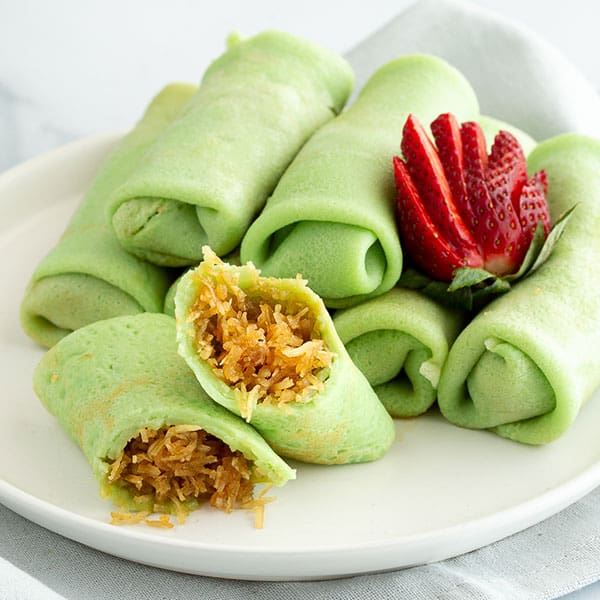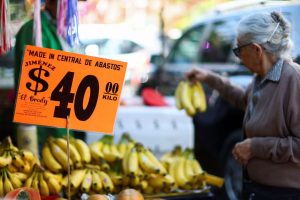Dadar Gulung is a traditional Indonesian dessert consisting of crepes filled with grated coconut and palm sugar. The name “Dadar Gulung” literally translates to “rolled crepes”. It is popular in various regions of Indonesia, particularly in Java and Bali.
The crepes are made from rice flour, eggs, coconut milk, and pandan juice (which gives them their characteristic green color). The filling is made from grated coconut and melted palm sugar.
It is usually served at room temperature. It can be presented on a decorated dessert plate or on trays during festive gatherings or events. It is sometimes accompanied by a cup of Indonesian tea or coffee.
To eat Dadar Gulung, a fork is used to cut the crepe into smaller portions. Some people also enjoy eating it with their hands, especially in casual settings. It is often eaten as a snack or dessert.
In different regions of Indonesia, there may be slight variations in the recipe:
- Color: Although the green color of crepes is traditionally due to pandan juice, some versions may be different natural colors if this ingredient is not used.
- Stuffed: Some versions may include additional spices or ingredients such as sesame seeds to vary the flavor.

How to make Dadar Gulung at home
Ingredients
The crepes:
- 100 g of wheat flour
- 1 egg
- 250 ml coconut milk
- 1-2 teaspoons pandan juice (or 2-3 drops pandan extract)
- a pinch of salt
- Vegetable oil to grease the pan
The Filling:
- 150 g grated coconut
- 100 g palm sugar (gula jawa), finely chopped
- 100 ml of water
- 1 pandan leaf (optional), tied in a knot
- a pinch of salt

Preparation of the Crepes:
- Mixing the Ingredients: In a bowl, beat the egg and add the coconut milk, pandan juice or extract, and a pinch of salt. Mix well.
- Add Flour: Slowly add the flour to the liquid mixture, whisking continuously to avoid lumps. The mixture should have a smooth consistency and a bright green color.
- Refrigerate (Optional): Let the mixture rest for about 15 minutes to improve the texture of the crepes.
- Cooking the Crepes: Heat a small nonstick skillet over medium heat and lightly coat with vegetable oil. Pour a small ladleful of the batter into the pan and spread it out to form a thin layer.
- Cooking by Sides: Cook each crepe for about 1-2 minutes on each side, until cooked through but not too brown. Repeat the process until all the batter is used up, greasing the pan as needed.
The Filling:
- Cooking Coconut and Palm Sugar: In a pan over medium heat, mix the shredded coconut, palm sugar, and water. Add the pandan leaf if using, and a pinch of salt.
- Cooking and Mixing: Cook the mixture, stirring constantly, until the sugar melts and combines well with the coconut. It should result in a sticky and aromatic mixture.
- Cool: Remove from heat and allow to cool slightly before using.
Dadar Gulung Assembly:
- Place the Filling: Place a crepe on a plate and put a generous spoonful of the coconut filling in the center.
- Roll up: Fold the sides of the crepe inward, over the filling, then roll up from one end to form a cylinder.
- Repeat: Repeat the process with all the crepes and filling.
Tips and Variations
- Pandan juice: If you don’t have pandan juice or extract, you can use green food coloring and vanilla essence as a substitute, although the flavor will be slightly different.
- Texture of the Crepes: Make sure the crepes are thin so they are easy to roll.
- Optional Filling: You can add a touch of ground cardamom or cinnamon to the filling to give it an extra dimension of flavor.




![[Img #74675]](https://thelatestnews.world/wp-content/uploads/2024/12/They-discover-a-new-class-of-X-ray-sources-in-the-150x150.jpg)













Add Comment